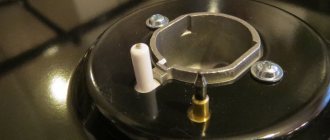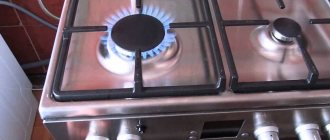- home
- Articles
- Why does the electric ignition of a gas stove constantly click?
The presence of automatic ignition in the design of a gas stove facilitates its operation and makes it possible to refuse the use of matches or lighters. But due to active use, this mechanism is more often prone to breakdowns than others. One of the most common problems is that the electric ignition of a gas stove constantly clicks, doing this spontaneously. The situation is unpleasant, but solvable.
Auto-ignition operating principle
To understand exactly why the spontaneous clicking of electric ignition occurs, you need to know the operating principles of this device installed on hobs.
There are two types of automatic ignition:
- Electromechanical - used on inexpensive models, now found less and less often;
- Electronic - more modern and comfortable to use.
The mechanical system allows you to quickly ignite the burner, but this requires two steps - simultaneously pressing the auto-ignition button and turning the gas supply knob. To create a spark, the design provides for a high-voltage capacitor and a spark gap. After pressing the and buttons, power is supplied to the capacitor, a breakdown voltage is generated at the spark gap and a spark is formed, igniting the flame in the burner.
Automatic ignition of the electronic type occurs after performing just one action - turning the gas supply knob, which is first slightly recessed inside. In such models, the handle is combined with the ignition system. Electronic ignition itself is somewhat different from mechanical ignition. It uses a high voltage capacitor, diodes, thyristors and transistors. As a result, the spark turns out to be of higher quality, which allows you to ignite the flame faster.
The described actions for any type of ignition take only a couple of seconds, but only if the equipment is connected to the power supply system and done correctly.
No spark - no fire
For convenience when using a gas stove, the flame is ignited by a spark.
In practice, this device turned out to be quite capricious. Ingress of water, grease, breakdown of wires, low voltage. The result is that the flame does not ignite from a spark and the stove does not work.
There are four components: a high-voltage block, wires, a button and a spark plug.
In addition, there are two types of electric ignition:
— manual (when you press the button, the capacitor is charged, when you release it, it discharges, there is a single spark)
Read also: Chicken hearts in the oven
— automatic (control of a circuit with a thyristor, a spark jumps with a frequency of 50 Hz)
- There is no spark when the burner is ignited:
The spark plug (white pin under the divider) must be cleaned of grease and correctly installed in the socket.
A candle is a millimeter thick iron wire hidden in porcelain. Breaking it is impossible even theoretically. Chips, cracks, dirt will send a spark in a different direction. The gas will not ignite, but there will be a spark.
If a spark appears, but the flame does not light up, clean the contact areas of the burner and candle. The spark should strike vertically into the gas supply hole of the burner.
Correct connection of a stove with electric ignition
If a regular stove only needs to be connected to a gas supply system, then models with automatic ignition also need to be connected to a 220-volt AC electrical network. To do this, each device is equipped with a three-core cable with a cross-section of at least 1.5 mm and a grounding plug. The outlet into which the equipment is connected must also be equipped with a grounding circuit. It is advisable not to use additional extension cords, adapters and tees, but to connect the device directly to the outlet.
A separate circuit breaker and additional protective equipment for connecting household appliances with ignition are not required, since the electricity consumption during its operation will be minimal.
Basic troubleshooting methods
To eliminate the source of the defect in the work, it is necessary to take action. Namely:
- Eliminate moisture. Due to the salts in the liquid, which, in fact, act as current conductors, the contacts close.
- Disassemble the structure and dry the button.
- Remove the old one and replace it with a new electric ignition.
- Easy cleaning.
- Make sure that only one button does not work; to do this, turn on the next burner; if ignition does not occur, then repair the button.
What can cause the auto-ignition to click in a gas stove and how to solve the problem
The reasons why the electric ignition of a gas stove clicks are different. In some cases, they can be easily fixed on your own, but according to the rules for operating devices connected to the gas supply system, their repair and maintenance must be carried out with the involvement of specialized services. If the device has been in use for many years, it may make sense to replace it with a new one.
Water ingress
If a breakdown occurred after general cleaning and extensive washing of this large equipment, then it is likely that excess moisture got inside, closing the network. In this case, you should not rush to call a specialist, but just wait 3-4 hours, sometimes 1-2 days, for the liquid inside to dry. To prevent unpleasant clicking from irritating your ears, simply disconnect the device from the power supply. Some sources advise that turning on the oven will help speed up the drying process. You should not resort to it, as this will aggravate the situation and lead to even greater damage. It is better to wait for the moisture to dry naturally.
Grease and dirt
In some cases, the spontaneous formation of a spark occurs simply because the ignition button is stuck due to grease and dirt accumulated around it. It is easier to remove dirt located around the and buttons. To do this, simply take a thin needle, which carefully removes dirt. It is extremely important to do this towards yourself to remove plaque, and not push it inwards.
If old grease has accumulated on the spring located behind the button, cleaning will be more difficult. In this case, you will need to remove the panel and clean it with alcohol. In some devices this can be easily done independently, while the design of others is more difficult to understand and you will have to call a specialist who is ready to repair household appliances at home.
In modern models of gas stoves, auto-ignition is often located not under a separate button, but is built into the rotary mechanism of the fuel handle. Also, during operation of the device and cooking, dirt often gets there, which causes spontaneous ignition. The solution to the problem is to remove the handles and thoroughly clean the mechanisms located behind them.
Oxidation of contacts
Residues of food, particles of detergents, water and other foreign objects during operation of the equipment inevitably fall into the electric ignition system. This cannot be avoided even with the most careful and careful handling of the device. As a result, the contacts oxidize, junctions appear, causing spontaneous clicking and the formation of a spark in all burners.
If the electric ignition does not turn off for this reason, then the solution to the problem will be to clean the contacts or replace them. If you have experience and knowledge, you can do this work yourself, but it is better to invite a specialist.
Malfunction of the ignition unit
The gas stove itself and its individual elements in particular have a certain service life and operating reserve. The ignition system is the element that is used most intensively, so it is expected that it will be one of the first to fail. The constant clicking in this case is caused by a short circuit inside this element. It is unlikely that you will be able to fix the problem yourself. What exactly to do if the gas stove clicks and the reason is a malfunction of the electric ignition unit, the technician will decide. In some cases, repairs are possible, but sometimes a complete replacement of failed equipment is required.
Oven thermostat does not regulate flame
Housewives who do not very well understand how the oven thermostat works often complain about this effect. If you have a stove with a thermostat, then when you change the position of the regulator, the flame may not change immediately. The thermostat works like this: first, while the oven is cold, the gas is supplied at full power, no matter how the engine is installed. As it heats up to the desired temperature (this is what is set on the regulator), the valve gradually closes and the flame decreases.
But two other malfunctions may be associated with the thermostat. Firstly
, after heating the oven, the flame may go out.
Secondly
, the flame may burn too hot, despite the fact that the oven has already warmed up. Both of these problems are caused by improper adjustment of the low fuel screw on the oven burner (Figure 3.A).
Figure 3. The faucet handles and the front panel under these faucets have been removed.
This screw needs to be turned out a little. Light the oven and close it. Set the regulator to 140 degrees. Wait 10 minutes. Now, by adjusting the screw, you need to ensure that the flame is small (the tongues are about 4 mm), but burns steadily and does not go out. Usually this is easy. But sometimes, even with the low flow screw fully tightened, the flame is too large. The fact is that there is a small hole in the screw, which prevents the gas supply from being completely blocked even when the screw is screwed in completely. Why this hole is needed, I still haven’t figured out. But the fact remains a fact. If the flame cannot be reduced to the required level, then the screw must be unscrewed completely and replaced with a screw with a smaller hole, or the hole must be sealed with Poxypol (it is absolutely useless). Then screw in the screw again and adjust the flame.
All of the above applies to an oven with a thermostat. The burner with tap is adjusted in the same way as the table burners. It is very easy to distinguish a thermostat from a faucet. Temperature values are written on the thermostat scale. The faucet scale has just numbers.
Is it possible to repair it yourself?
The question of whether to repair it yourself or call a specialist is always decided individually, depending on why the gas stove with electric ignition clicks and how accurately it was possible to determine the causes.
If you are sure that the malfunction is caused by water ingress, then it is enough to disconnect the device from the network for a while and wait for it to dry. After 2-4 hours or a couple of days, the clicks will disappear and there will be no need for repairs.
If the breakdown is due to dirt, then it is possible to clean the outside yourself, but very carefully. But it is not worth violating the integrity of the equipment without specialized knowledge in the field of operation of such equipment. Maintenance and repair of gas stoves are not so expensive that you would risk the health and life of yourself and your family members for the sake of dubious savings.
Prevention measures
Regular preventive maintenance of the device will help to avoid breakdowns and prolong the operation of the oven. Follow the operating instructions for the equipment. Follow the cooking technologies for different dishes and the recommended temperatures for them. View the design of various oven components. Recommendations for washing and lubricating elements are also important.
After finishing the baking or stewing process, always keep the walls and bottom clean, this will help improve the functioning of the appliance. Remove dirt and food debris. This will prevent the internal parts of the oven from becoming clogged and damaged. Use high-quality household chemicals for washing. Cheap powdered products scratch the glass of the door, destroy the enamel, and make the seal hard.
Ovens are considered reliable appliances. If the device breaks down, specialist help is not always required. Some problems can easily be fixed with your own hands. For example, cleaning individual elements, replacing regulators, seals, heating coils, adjusting the oven door and thermocouple. When you cannot find the cause of the breakdown, you cannot do without calling a service center employee. Usually problems can be solved, and repairs do not take much time.
To learn how to repair an oven in a gas stove, see the following video.
Our advantages
The Remontano workshop invites clients in Moscow and the region who have encountered problems with induction cookers to cooperate. We will promptly restore serviceability at reasonable prices. The cost of work is determined by diagnostics and does not change until the services are completed. Other advantages include:
- Extensive experience working with household appliances.
- We repair induction, electric, gas stoves and panels.
- We work with brands Gorenje, Bosch, Zanussi, Ariston, Kaiser and others.
- We carry out home repairs of any complexity.
- The work schedule is from 7:00 to 23:00 allowing you to choose a comfortable time.
- Travel around the city is provided free of charge.
How it works
Electric ignition can only be used on gas stoves. Its main function is to ignite the blue fuel as it exits the burner divider installed on the gas stove. It comes in automatic and mechanical types
. In the first option, special piezoelements ignite the gas-air mixture when turning a switch on the control panel, and in the second case, the user must press a special button. A spark ignites the gas and you can start cooking. The automatic gas ignition device is the most capricious and unreliable device in the entire arsenal that is equipped with a modern gas stove.
Very important! Never try to turn on the system if the burners are removed - a breakdown of the housing is guaranteed.
Taken together, the entire operation of this system looks like this:
- the user presses the button, thereby applying voltage to the capacitor, which begins to charge;
- the level on the thyristor gradually increases, when it reaches the set threshold, the capacitor is discharged;
- At the output of the entire system, a voltage arises, which activates a special device - a spark gap;
- a spark ignites the gas.
The whole system works much faster than we talk about it. The spark is supplied to the burner that is currently turned on (in older models it was supplied to all devices, but the one where gas access was ignited). The start buttons are located under the controls. Electric ignition is powered from the network
with alternating current of 220 volts and is vulnerable to voltage surges, which occur quite often. After a power surge, it may constantly click, which indicates that it is broken.
The system will only work if a separate cable plug is connected to the home electrical network, which many users forget about and call the service with complaints.
Possible consequences
If liquid floods a gas stove burner, the most dangerous consequence is an extinguished flame. If the model is not equipped with a gas control system (or the safety element does not function), this may lead to gas contamination and an explosion. If you find gas turned on without a fire, you must immediately shut off the supply of flammable substances and ensure maximum ventilation of the room. If the owner floods the gas stove with water, common malfunctions:
- Failure of the electrical ignition - it is necessary to check the contacts and electronic components (a task for a specialist). Contact shorting usually disappears after the moisture dries. If the auto-ignition unit gets wet, it will have to be replaced entirely.
- Nozzles are clogged (the burner does not burn, or the combustion is weak and unstable) - the burner is dismantled, the nozzle hole is carefully cleaned with a thin object (for example, a needle). If you find strong obstacles that cannot be removed without much effort, it is better to contact a specialist.
- The appearance of soot from the burners. This is caused by pollution and blockages resulting from flooding. It is enough to remove the blockage and check the condition of the flame diffuser.
- There are many reasons for a decrease in pressure, including liquid in the gas supply system.
- Failure of the thermocouple or solenoid valve will require replacement.
Corrosion is unlikely because the surfaces in contact with the liquid are enameled.
What to do if the piece constantly clicks on its own
It is necessary to find the sources of problems . Next, follow the instructions for eliminating operational defects that are written in this article. Brush up on all your knowledge about this. It is important not to panic in any situation, strictly follow the rules, only then the outcome of events will be favorable.
REMEMBER!
Most damage can be repaired yourself - it is harmless.
How to troubleshoot at home
Here are steps that can help resolve the possible problem.
ATTENTION!
Under no circumstances use an oven when drying, otherwise moisture will accumulate in huge quantities; let it evaporate naturally.
- When braking the button (using a spring) due to the accumulation of grease and dirt, you need to release the handle and, using a brush, thoroughly clean and allow the rod to dry. It is not guaranteed that the click will be on its own, as before. There is an option when the button will not be pressed all the way due to the low fit.
REFERENCE!
For more productive cleaning, use a soap solution
The unit must be replaced if the unit is used for a long time. This is a natural phenomenon, so sounds can be avoided in such a situation in only one way.
- If only one burner does not work, then the problem is that the wire is damaged; the fault lies in the channel itself of the entire unit.
- If the burner is faulty, it should be replaced.
- However, if the click continues to repeat, you should use a lighter or matches to ignite it.
- Or call a professional technician who can accurately diagnose the cause and repair your equipment.
Troubleshooting
Immediately after purchase, you should carefully inspect the unit and find out whether all its visible elements (door, switches, grilles, etc.) are securely fastened in place. After this, you should connect the unit to the network and run some kind of gentle program “idle” - this way you can find out whether there is a manufacturing defect.
Most often, owners of electric stoves from the following manufacturers face the problem of extraneous sounds: Gorenje, Indesit, Gefest, Zanussi, Hansa, Kaiser and Electrolux.
Conclusions and useful video on the topic
Concluding the review of the defect of a constantly clicking gas stove, as well as the possibilities for correction, we recommend that you familiarize yourself with the thematic video below:
In some cases, eliminating the defect is quite possible on your own. However, theoretically and in accordance with the rules, any malfunctions of gas stoves are the prerogative of special (gas) services. This approach is determined primarily by considerations of general fire safety, and not just by the owner of the household appliance itself.
Have you recently eliminated the cause of spontaneous ignition in your stove? Share your experience with other visitors to our site, leave your comments and recommendations, add unique photos taken during the process of repairing the ignition button - the feedback form is located below.
Fill out the form and get a 10% discount
We do not invent or post reviews about ourselves on our website. For objective information, read reviews about Express Service on external sites.
Replies (1 - 10)
The essence of the problem: Ariston gas panel. The left row of burners refuses to light up from the piezo, the right one lights up with a bang. A weak spark, if you look closely and listen, the clicks are weak. If the burner is warmed up, let’s say you’ve been cooking soup, then the piezo no no goes off. I’ll answer right away: I cleaned the diffusers and dried everything around from water, but the spark of the reptile does not come. There are a lot of things written on the Internet, including switching to matches, but I want to have a working device. Can anyone tell me if there is a solution to this problem? Thank you.
It is necessary to clean and dry not only what is visible “around”, but what is hidden
under
the top panel. For good measure, of course it would be necessary to remove it. There, inside, before you start really cleaning, you can see if the wiring is sparking between each other or on the body. Especially those that go to the left. You can see in the dark. If you notice sparks in inappropriate places: the wiring and everything around it, wash it from dirt and grease, push the wiring apart/move it aside/wrap it with electrical tape...it should work.
If nothing extra sparks, you can try switching the wires from right to left. If there is still a bad spark on the left, it means something is wrong with the spark gap itself, near the diffuser. But this is unlikely. If it works on the left, but it becomes bad on the right, then the problem is in the spark block itself - it is better to change it.
Usually the problem is dirt underneath.
panel, in the area of the spark plug, that’s where it’s easiest for the soup to get inside...what do you most often cook on the left? The last time I did something like this, I simply sprayed WD-40 directly through the crack, waited for the dirt to become saturated and wet, and blew everything out as much as possible with a powerful stream of air (from a can). Without taking anything apart. It worked like new... but of course temporarily, the soup will return after some time and shorten again... (IMG.
| For ease of use, gas hobs are equipped with automatic ignition, which is powered from the electrical network. To do this, specialists from a company producing household appliances place an electric ignition unit in the design of the hob. When you press the handle: a block of electrical impulses drops a spark onto the burner, thereby igniting it. When the handle is released, the spark stops. But what if you remove your hand and the hob continues to click and spark? In some cases, this is a serious breakdown that requires immediate professional attention, so if you encounter a similar malfunction, contact our service for repairs. While you call our technician, we will describe in as much detail as possible all the possible reasons why the hob is clicking. |
Reliable household appliances delivered to your home
The official website of our online store offers a large selection of products from the German brand Korting. Functional hobs with ovens and microwaves will create all the conditions for preparing dishes of any complexity. Modern washing machines and dishwashers will free you from the most unpleasant household chores. Built-in and free-standing refrigerators will ensure the safety of your favorite foods and drinks. Powerful hoods will help clean the air in the kitchen while cooking.
The company has demonstrated its commitment to German quality standards since 1889. The equipment is produced in several collections; models in various styles are widely represented, from retro to hi-tech. A user-friendly interface, high performance and extensive functionality will satisfy the wishes of the most demanding client. All products are covered by an official manufacturer's warranty. Delivery of goods is carried out in Moscow, St. Petersburg and all regions of the Russian Federation.
Why does the hob keep clicking?
To eliminate the causes in the electronic ignition system of gas stove burners and hobs, it is important to know the theoretical foundations and operating principles. When you press a knob or button, an electric spark appears at the spark plug, which ignites the gas. The electric spark is generated by the ignition unit. After the gas has ignited, you continue to hold the knob pressed for a few more seconds to magnetize the gas control system. When you turn on the burner, we hear characteristic clicks, which stop when the handle is released.











